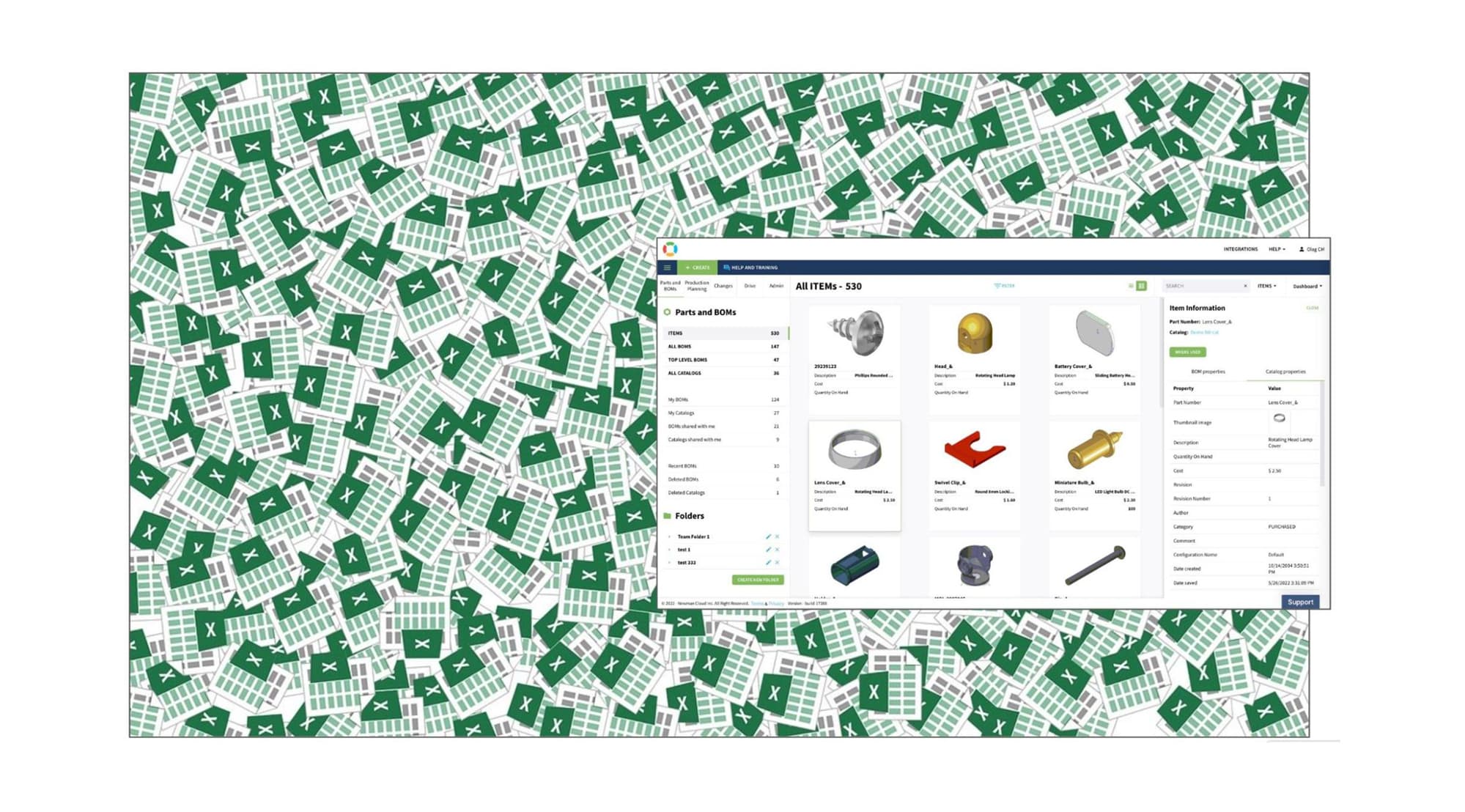
As manufacturing companies are moving forward to discover the future of digital transformation, the question of how to make the shift is coming more often. While no one really is questioning the needs of businesses to connect their data silos, streamline engineering to manufacturing processes, and establish a digital thread of information, I can see a larger number of companies are struggling with the practical steps of transforming their data management and operation as well as finding an easy way to switch from their existing legacy data management practices into a digital future.
Unbundling Excel
Excel is the status quo in many industries. In fact, Spreadsheets make up every industry. Spreadsheets usage has multiple scenarios and spreadsheets can be tailored to a specific industry need. Spreadsheets are simple and easy, they don’t require training thanks to decades of usage. The manufacturing economy is literally run on spreadsheets – you can see them in small moms and pops shops and also in billion dollars manufacturing corporations. Even more, engineers and IT people that built solutions using Excel or other spreadsheets are super proud of their capabilities to create tricky spreadsheets to manage data. Until… it stops working, requires time and money to fix or doesn’t scale, and must be translated into another solution. The trigger for this event can be anything. It is usually a mistake that triggers project delay, quality issues, cost increases, or something bigger such as missing regulation or getting in trouble with customer issues and litigations. You don’t want to be around when one of these events is happening, therefore manufacturing companies need to develop a plan to unbundle Excels before bad scenarios occur.
Old Habits Die Hard
It is easy to say “get rid of Excel or spreadsheets”. Most of the companies we meet have a clear understanding that this is what they need to do. However, they are facing the brutal reality of changes. Everything you do is quickly becoming part of your habits. Everything manual process, data organization, exchange, calculations, etc. – all these things are part of your regular data management habits. Where to store the data, how to change it and how to share – every company using spreadsheets as a data management tool is facing the brutality of the change process. In other words, how to get yourself from state A to state B when “A” is what you do every day.
How to make the move easier and start a process of unbundling? Here are the three steps strategy I recommend to all manufacturing companies that come to OpenBOM and ask to help them to switch.
- Define the data scope you need to manage including how you identify the data
- Agree on how data will be stored and accessed by multiple users and roles
- To cut your current data management practice and move data to a new “place”
3 Steps of Moving from Spreadsheets To OpenBOM
OpenBOM gives you a flexible data management platform to organize information about items, bills of materials, and manage changes.
Items, Catalogs, BOMs,
Everything is an item – single parts, components, materials, assemblies, and products. Use OpenBOM catalog systems to define item types, their attributes, and identification (Part Numbers). This is the most important part of the process as you will be defining a fundamental data element of the product – items. To get prepared you need to think about all your data and define these Item Types and their attributes. Once you are done, you can create an OpenBOM catalog for each item type.
Bill of Materials are using items to define products. A basic bill of materials in OpenBOM is associated with an Item via (BOM Part Number) and includes a list of items. Each of them can have its own BOM. All together you get a multi-disciplinary multi-level BOM.
Data access, roles, and user-defined views
OpenBOM is an online platform that allows you to access data via user accounts. You can have a single user account, team, or company. OpenBOM is a multi-tenant system and everyone gets data access via data ownership and data sharing capabilities. Users can share data with other users and teams/Companies can have role-based access to catalogs and BOMs based on their team settings. User-defined views can be used to limit your access to the data. The same user-defined views can be used for sharing (including automatic team views). So, every user is getting seamless access to the data and OpenBOM allows you to share data in your company and outside of the company in real-time.
Import Existing Data
You should prepare the data for import using the formats described in OpenBOM’s training library. You will be importing data for catalogs and BOMs separately. First, we recommend importing all catalogs and ensuring that everything is saved in the way you want, all attributes are defined and all the data from Excel used to define these items are now imported. After catalog data import, you can import BOMs. OpenBOM can import multi-level BOMs as well as single-level BOMs. There is no need to have a specific data order- you can do it bottom-up and top-down. OpenBOM will connect it together.
The process I described above can be simplified if you use OpenBOM CAD add-ins, which allow you to export data directly from your CAD system automatically creating Catalogs and BOMs. The process is called “one-click BOM” and can deliver a BOM from any CAD system OpenBOM has integration with.
Conclusion
Old and bad habits are dying hard. Managing BOMs and all related information using spreadsheets, emails, and shared drives is a very bad and inefficient way to do so. It will eventually get you in trouble by making mistakes and losing data, customers, and money. Therefore “unbundling Excels” is the process to get rid of your bad habits and move to a better way of managing the product lifecycle and all data involved in this process.
At OpenBOM we developed an online platform that can help you to do so painlessly and seamlessly. REGISTER FOR FREE to check out how OpenBOM can help you and your team today.
Best, Oleg
Join our newsletter to receive a weekly portion of news, articles, and tips about OpenBOM and our community.










